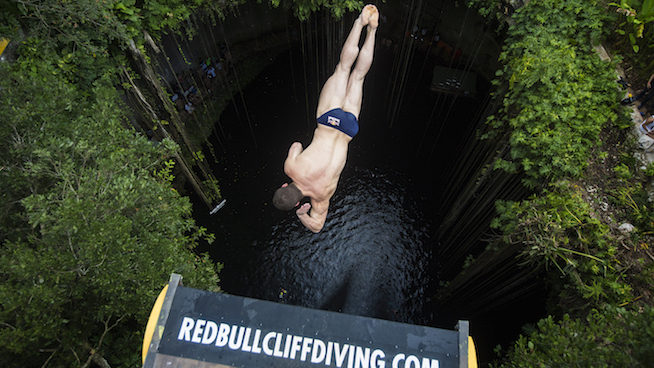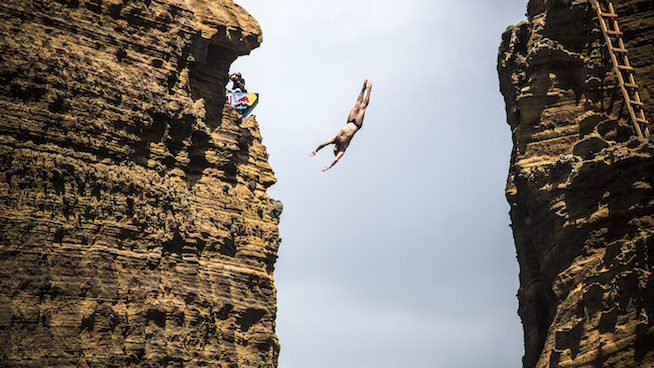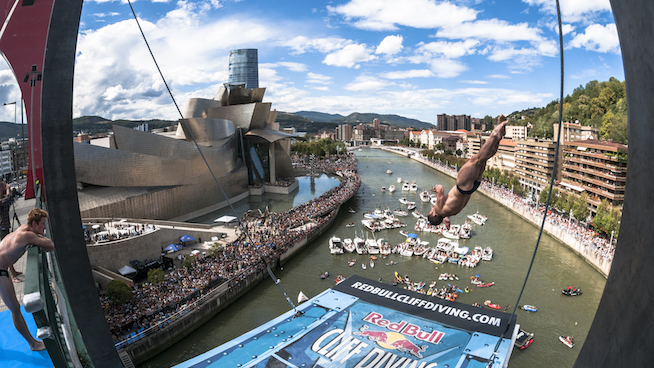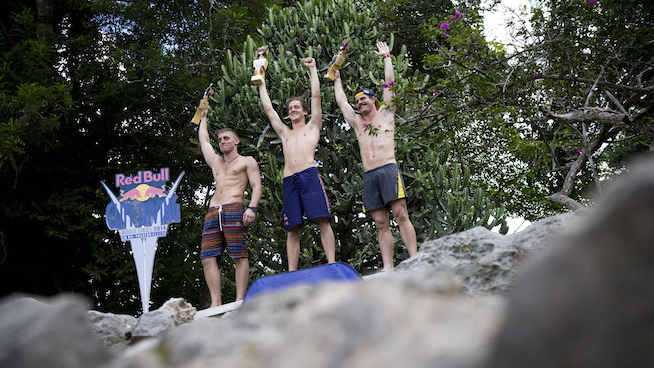Face Your Fear: An Inside Look at the Thrilling Sport of Cliff Diving
![]()
What do you get when you combine topflight diving talent, death-defying heights and breathtaking exotic locales? The Red Bull Cliff Diving World Series, an annual event that features fearless, world-class divers competing for supremacy in some of the most unique places on earth.
The sport is a physical test, for sure, but it’s the mental aspect that makes these athletes unique. The men dive from heights as high as 92 feet, the women from as high as 69 feet. (For perspective, the highest Olympic diving platform is 33 feet high.) Diving from such heights leaves the margin for error slim, and as much effort is spent mentally preparing for a competition as is spent physically.
STACK spoke with Rachelle Simpson, a 27-year-old San Antonio native and the 2014 women’s World Series Champion, and David Colturi, a 25-year-old former collegiate All-American diver and the fifth overall finisher in the 2014 men’s World Series, about what it takes to be a cliff diver.
Living on the Edge

David Colturi
Although the physical aspect certainly takes talent and preparation, Colturi believes it is not the biggest part of cliff diving. He says, “I’ve always said that there are thousands of talented platform divers who could do the dives in cliff diving, but it’s the mental side that really separates people. The potential dangers are very high and possibly fatal. The physical part isn’t easy, but you have time to work on it. You can practice the dives, and if you’ve done them before, you can make it happen. But I always tell everyone the mental aspect is the biggest and hardest part.”
Concussions, torn ligaments, broken bones, whiplash, torn muscles, separated pelvis—they’re all fairly common injuries in the world of cliff diving. A badly flubbed dive has the potential to be fatal. When the risks are so high, mental focus and visualization play huge roles. “Knowing you have to be pretty close to perfect to avoid injury, it’s a lot of pressure,” Simpson says.
Both Colturi and Simpson visualize their dives over and over in their heads, knowing it will help their bodies perform when the time comes to take the plunge. “I like to go lie down and just visually go through all my dives,” says Colturi. “I do it from a first-person perspective, what I’ll see when I do the dive, and also a third-person perspective, watching myself do the dive from someone else’s perspective. What it will look like to the judges. I also do a lot of deep breathing and working on controlling my heartbeat.”
No matter how much visualization a diver does, nerves inevitably kick in when he or she is looking down at the watery landing 10 stories below. “When you first step out onto the platform and look down, your heart is beating out of your chest,” Colturi says.
Both divers agree that the best approach is to try to clear your head, get in position and let muscle memory take over. Too much indecision causes issues. Simpson says, “I had a coach who always told me, you can give yourself three seconds. After that, you start doubting yourself and fear can set in. So many potential errors can start jumping into my head if I think too much. My body knows what I’m doing. There’s no use standing there and being afraid. It’s one, two, three, go!”
“If you focus on the things you can’t control, it will adversely affect the things that you can control,”Colturi says. “The environment, the other divers, the scores, you’ve got to clear it all out. I just think of a few simple cues and let my body take over.”
Divers can use the long walk, climb or hike back up to the platform between dives as a time to focus. “Depending on the location we’re at, you’re either climbing a huge ladder, going up a giant set of steps or physically hiking back up a mountain to return to the platform. It’s draining, but it also gives you time to take a deep breath and think about your next dive,” Simpson says.
RELATED: Red Bull Frozen Rush: The Coldest Race on Four Wheels
Higher and Higher

David Colturi
How does one end up plunging from such dangerous heights for sport? “It’s not really something that you just start doing when you’re young,” Colturi says.
Both Colturi and Simpson grew up participating in traditional platform diving—Simpson’s platform diving career concluded after high school, and Colturi’s after a decorated career at Purdue University. But both wanted to keep doing the thing they loved. “After school, there’s really no professional diving league or stuff like that. If you want to keep traditional platform diving, it’s pretty much Olympics or bust. But after I graduated, I found out about this whole new world of diving shows,” Colturi says.
Despite the fact that these entertainment shows require diving from much higher platforms than they were used to, both divers embraced the challenge. Simpson dove at Sea World and a cirque du soleil style show in China, and Colturi dove at an amusement park in Indiana. When they eventually heard about the Red Bull Cliff Diving World Series, they jumped at the chance to compete. Luckily, they were talented (and fearless) enough to make the cut.
Cliff diving is judged similarly to traditional platform diving. The two biggest differences are that the greater heights allow for more complex dives; and cliff divers enter the water feet first instead of head first. The force of impact from such heights is simply too great to enter head first. “You’re graded on your take off, your form in the air, your positioning, your speed, your flexibility and your entry,” Simpson says.
Built for Impact

Cliff diving requires full-body strength, but two areas, the lower body and the core, are particularly important, not only for functional diving movements such as explosive take-offs and controlled rotations, but also for withstanding impact. Hitting the water from such incredible heights has been compared to enduring a car crash or landing on concrete—even when you “rip” your entry, a term referring to a clean, tight entry accompanied by little splash.
Strength is the difference between expected pain and serious injury. “It’s really easy to hit the water and have your legs split apart by the force. A lot of people tear their groins or put a hip out of position or injure their back like that,” Simpson says.”Anything above the knees and below the chest can get very sore,” Colturi says.
To get the results they want and avoid injury, both divers spend a lot of time training. Simpson likes to spend time in the weight room, hitting lower-body exercises like Squats and Deadlifts, and Colturi likes cycling and plyometric workouts. And both do tons of core work to keep their midsections strong.
Being flexible isn’t just an advantage in cliff diving—it’s a necessity. Not only do the dives require your body to contort and twist, but the impact can move your limbs into undesirable positions. Thus, both Colturi and Simpson are avid yoga fans. Simpson says, “I love hot yoga. It warms my body up so I can get into deeper stretches. The active flexibility of yoga translates better than normal stretching for me—I’m not just stretching and then tightening up immediately after.”
An Unparalleled Rush

Gary Hunt (UK), Artem Silchenko (Russia) and David Colturi (USA)
The feeling of pure adrenaline after a dive is unmatched. “I love that feeling of overcoming your fear. It’s empowering and addicting,” Simpson says.
The high after a competition can be so intoxicating that it takes a concerted effort to look back and reflect on your performance. Colturi says, “It’s huge to reflect after you dive. You have such a big rush after you compete, and Red Bull knows how to throw a good after-party. So it can be easy to just ride your adrenaline and not really reflect on how you did. You really have to step back and think: how was my performance? Did I stick to my plan? That’s how you grow as a diver.”
Aside from the electrifying excitement they feel after taking a plunge, both Colturi and Simpson cite the locations they get to visit as one of their favorite parts of cliff diving. “I love the diving, that’s why I’m in it. But the experience is awesome,” Simpson says. “The places we get to go to are incredible. Norway was my favorite so far, it was just amazing.” Colturi agrees, “You go to these amazing cool places and meet really cool people.”
Looking ahead to the upcoming season, both divers are looking to outdo themselves. “I really want to fix my takeoff and bring in a new dive. I just want to always beat myself. I don’t go into an event thinking, oh, I need to win. If I win, that’s awesome, but for me, my biggest competitor is myself,” Simpson says.
“I just want to get onto the podium more consistently,” says Colturi. “Get on the podium as much as possible. I want to nail my new dive and end up on the podium more often.”
If you want to get an up-close look at Simpson and Colturi, the Red Bull Cliff Diving World Series will be making a stop in Fort Worth, Texas on May 30th.
RELATED: Flying High with Red Bull’s Wes Agee
RECOMMENDED FOR YOU
MOST POPULAR
Face Your Fear: An Inside Look at the Thrilling Sport of Cliff Diving
![]()
What do you get when you combine topflight diving talent, death-defying heights and breathtaking exotic locales? The Red Bull Cliff Diving World Series, an annual event that features fearless, world-class divers competing for supremacy in some of the most unique places on earth.
The sport is a physical test, for sure, but it’s the mental aspect that makes these athletes unique. The men dive from heights as high as 92 feet, the women from as high as 69 feet. (For perspective, the highest Olympic diving platform is 33 feet high.) Diving from such heights leaves the margin for error slim, and as much effort is spent mentally preparing for a competition as is spent physically.
STACK spoke with Rachelle Simpson, a 27-year-old San Antonio native and the 2014 women’s World Series Champion, and David Colturi, a 25-year-old former collegiate All-American diver and the fifth overall finisher in the 2014 men’s World Series, about what it takes to be a cliff diver.
Living on the Edge

David Colturi
Although the physical aspect certainly takes talent and preparation, Colturi believes it is not the biggest part of cliff diving. He says, “I’ve always said that there are thousands of talented platform divers who could do the dives in cliff diving, but it’s the mental side that really separates people. The potential dangers are very high and possibly fatal. The physical part isn’t easy, but you have time to work on it. You can practice the dives, and if you’ve done them before, you can make it happen. But I always tell everyone the mental aspect is the biggest and hardest part.”
Concussions, torn ligaments, broken bones, whiplash, torn muscles, separated pelvis—they’re all fairly common injuries in the world of cliff diving. A badly flubbed dive has the potential to be fatal. When the risks are so high, mental focus and visualization play huge roles. “Knowing you have to be pretty close to perfect to avoid injury, it’s a lot of pressure,” Simpson says.
Both Colturi and Simpson visualize their dives over and over in their heads, knowing it will help their bodies perform when the time comes to take the plunge. “I like to go lie down and just visually go through all my dives,” says Colturi. “I do it from a first-person perspective, what I’ll see when I do the dive, and also a third-person perspective, watching myself do the dive from someone else’s perspective. What it will look like to the judges. I also do a lot of deep breathing and working on controlling my heartbeat.”
No matter how much visualization a diver does, nerves inevitably kick in when he or she is looking down at the watery landing 10 stories below. “When you first step out onto the platform and look down, your heart is beating out of your chest,” Colturi says.
Both divers agree that the best approach is to try to clear your head, get in position and let muscle memory take over. Too much indecision causes issues. Simpson says, “I had a coach who always told me, you can give yourself three seconds. After that, you start doubting yourself and fear can set in. So many potential errors can start jumping into my head if I think too much. My body knows what I’m doing. There’s no use standing there and being afraid. It’s one, two, three, go!”
“If you focus on the things you can’t control, it will adversely affect the things that you can control,”Colturi says. “The environment, the other divers, the scores, you’ve got to clear it all out. I just think of a few simple cues and let my body take over.”
Divers can use the long walk, climb or hike back up to the platform between dives as a time to focus. “Depending on the location we’re at, you’re either climbing a huge ladder, going up a giant set of steps or physically hiking back up a mountain to return to the platform. It’s draining, but it also gives you time to take a deep breath and think about your next dive,” Simpson says.
RELATED: Red Bull Frozen Rush: The Coldest Race on Four Wheels
Higher and Higher

David Colturi
How does one end up plunging from such dangerous heights for sport? “It’s not really something that you just start doing when you’re young,” Colturi says.
Both Colturi and Simpson grew up participating in traditional platform diving—Simpson’s platform diving career concluded after high school, and Colturi’s after a decorated career at Purdue University. But both wanted to keep doing the thing they loved. “After school, there’s really no professional diving league or stuff like that. If you want to keep traditional platform diving, it’s pretty much Olympics or bust. But after I graduated, I found out about this whole new world of diving shows,” Colturi says.
Despite the fact that these entertainment shows require diving from much higher platforms than they were used to, both divers embraced the challenge. Simpson dove at Sea World and a cirque du soleil style show in China, and Colturi dove at an amusement park in Indiana. When they eventually heard about the Red Bull Cliff Diving World Series, they jumped at the chance to compete. Luckily, they were talented (and fearless) enough to make the cut.
Cliff diving is judged similarly to traditional platform diving. The two biggest differences are that the greater heights allow for more complex dives; and cliff divers enter the water feet first instead of head first. The force of impact from such heights is simply too great to enter head first. “You’re graded on your take off, your form in the air, your positioning, your speed, your flexibility and your entry,” Simpson says.
Built for Impact

Cliff diving requires full-body strength, but two areas, the lower body and the core, are particularly important, not only for functional diving movements such as explosive take-offs and controlled rotations, but also for withstanding impact. Hitting the water from such incredible heights has been compared to enduring a car crash or landing on concrete—even when you “rip” your entry, a term referring to a clean, tight entry accompanied by little splash.
Strength is the difference between expected pain and serious injury. “It’s really easy to hit the water and have your legs split apart by the force. A lot of people tear their groins or put a hip out of position or injure their back like that,” Simpson says.”Anything above the knees and below the chest can get very sore,” Colturi says.
To get the results they want and avoid injury, both divers spend a lot of time training. Simpson likes to spend time in the weight room, hitting lower-body exercises like Squats and Deadlifts, and Colturi likes cycling and plyometric workouts. And both do tons of core work to keep their midsections strong.
Being flexible isn’t just an advantage in cliff diving—it’s a necessity. Not only do the dives require your body to contort and twist, but the impact can move your limbs into undesirable positions. Thus, both Colturi and Simpson are avid yoga fans. Simpson says, “I love hot yoga. It warms my body up so I can get into deeper stretches. The active flexibility of yoga translates better than normal stretching for me—I’m not just stretching and then tightening up immediately after.”
An Unparalleled Rush

Gary Hunt (UK), Artem Silchenko (Russia) and David Colturi (USA)
The feeling of pure adrenaline after a dive is unmatched. “I love that feeling of overcoming your fear. It’s empowering and addicting,” Simpson says.
The high after a competition can be so intoxicating that it takes a concerted effort to look back and reflect on your performance. Colturi says, “It’s huge to reflect after you dive. You have such a big rush after you compete, and Red Bull knows how to throw a good after-party. So it can be easy to just ride your adrenaline and not really reflect on how you did. You really have to step back and think: how was my performance? Did I stick to my plan? That’s how you grow as a diver.”
Aside from the electrifying excitement they feel after taking a plunge, both Colturi and Simpson cite the locations they get to visit as one of their favorite parts of cliff diving. “I love the diving, that’s why I’m in it. But the experience is awesome,” Simpson says. “The places we get to go to are incredible. Norway was my favorite so far, it was just amazing.” Colturi agrees, “You go to these amazing cool places and meet really cool people.”
Looking ahead to the upcoming season, both divers are looking to outdo themselves. “I really want to fix my takeoff and bring in a new dive. I just want to always beat myself. I don’t go into an event thinking, oh, I need to win. If I win, that’s awesome, but for me, my biggest competitor is myself,” Simpson says.
“I just want to get onto the podium more consistently,” says Colturi. “Get on the podium as much as possible. I want to nail my new dive and end up on the podium more often.”
If you want to get an up-close look at Simpson and Colturi, the Red Bull Cliff Diving World Series will be making a stop in Fort Worth, Texas on May 30th.
RELATED: Flying High with Red Bull’s Wes Agee














